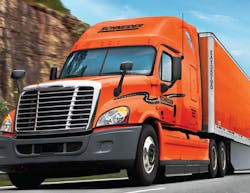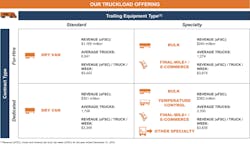Schneider National Inc. made it official Friday, announcing the launch of a $500 million initial public offering to pay off debt and expand operations. Schneider, the largest privately held trucking company in the U.S. by revenue, had said last October it intended to pursue the IPO, “subject to satisfactory market conditions.”
The objectives of the IPO are to “facilitate continuity of controlling ownership of Schneider by the future generations of the Schneider family, while continuing forward with its long-standing, independent, and professional, corporate governance structure,” the company said.
According to its March 24 Form S-1 filing with the Securities and Exchange Commission, Schneider reported net income of $156.9 million on $4 billion in revenue for the 2016 fiscal year. The company's portfolio consists of approximately 10,500 company and 2,850 owner-operator trucks, 37,900 trailers and 18,100 intermodal containers across North America and approximately 19,300 "enterprise associates."
“We believe we offer one of the broadest arrays of services in the transportation and logistics industries, ranging from dry van to bulk transport, intermodal to supply chain management and first to final mile ‘white glove’ delivery,” the filing states. “We believe we differentiate ourselves through expertise in services that utilize specialty equipment, which have high barriers to entry.”
Among the investment risks, the company cites the “inherently” competitive nature of the truckload industry, the “significant portion of revenue” Schneider makes from its largest customers (30% coming the top 10), the challenges of driver recruiting and retention, and the “increased costs” associated with regulatory compliance.
The 28,947,000 shares of its Class B common stock will be offered at initial public price between $18 and $20 per share, coming in at around $550 million.
Schneider will use $100 million of the net proceeds to repay senior notes and another $50 million to cover amounts outstanding under an accounts receivable facility. The company intends to use the remaining net proceeds for general corporate purposes, including capital expenditures, such as chassis purchases of approximately $110 million as part of a plan to convert from a rented chassis model to a company-owned chassis model, the filing states.
Schneider’s Class B common stock has been approved for listing on the New York Stock Exchange under the symbol "SNDR," subject to official notice of issuance.
About the Author
Kevin Jones 1
Editor
Kevin has served as editor-in-chief of Trailer/Body Builders magazine since 2017—just the third editor in the magazine’s 60 years. He is also editorial director for Endeavor Business Media’s Commercial Vehicle group, which includes FleetOwner, Bulk Transporter, Refrigerated Transporter, American Trucker, and Fleet Maintenance magazines and websites.

